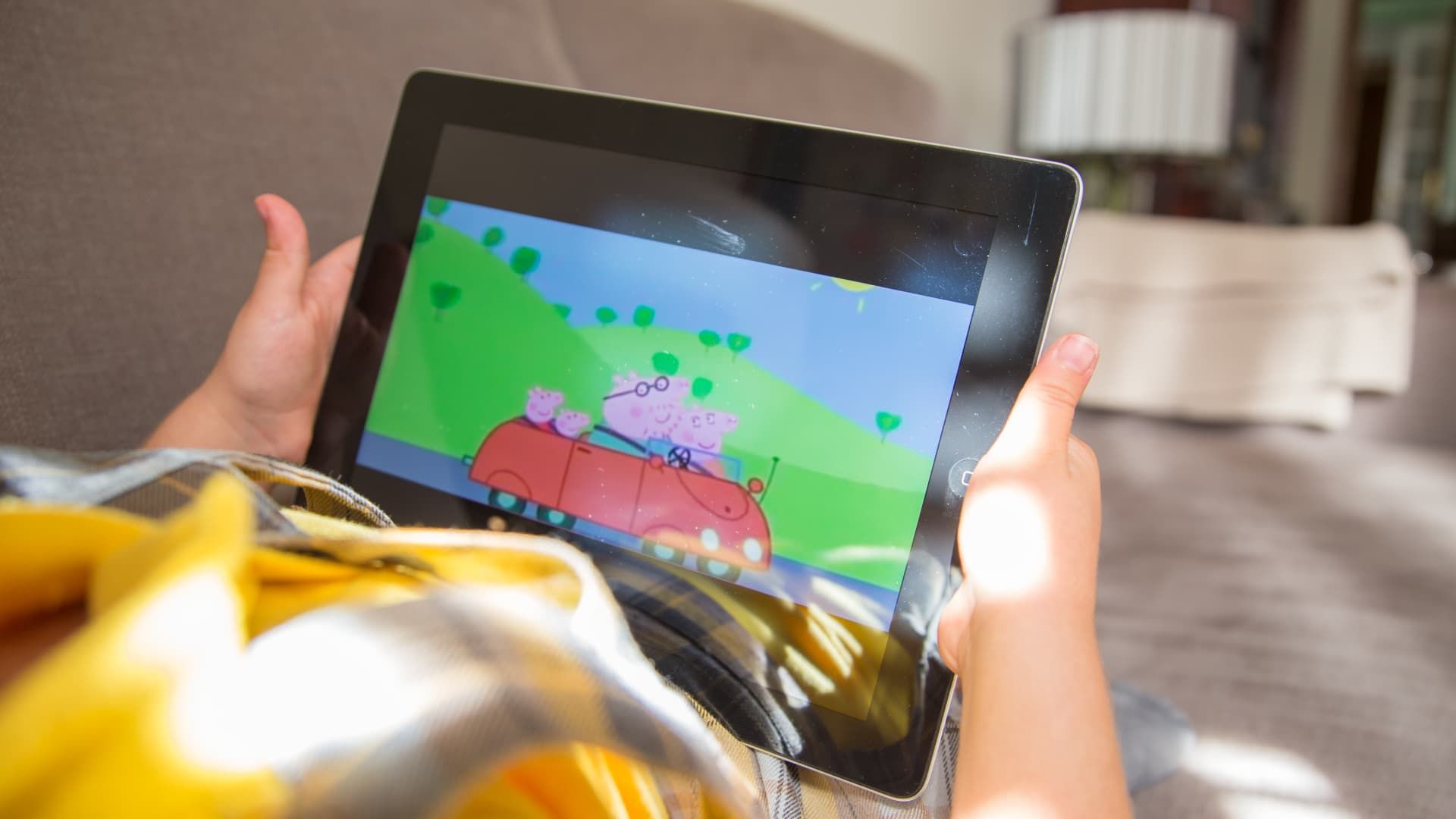Tinky-Winky, Laa-Laa, Dipsy and Po pose for a photo as the Teletubbies celebrate their 25th anniversary with the lighting of the iconic Empire State Building on April 26, 2022 in New York City.
Juan Lamparski | Getty Images Entertainment | fake images
“Tinky Winky. Dipsy. Laa-Laa. Po!”
Those four names, the iconic sung intro to “The Teletubbies,” have appeared on home televisions for almost 30 years. While the episode library hasn't changed in decades, its role in American media has taken on new meaning in the streaming era.
“Television was a little simpler back then,” said Dean Koocher, a television expert who spent years bringing international children's shows, including “Teletubbies” and “The Wiggles,” to the Americas.
“Back then there were fewer gatekeepers, you know, there was PBS, Disney and Nickelodeon, which was kind of an upstart,” Koocher told CNBC. “The good thing was, if you could ever catch their eye, you had a much bigger share of the market, because there weren't as many options for kids.”
Now, shows aren't just on traditional television and there are many more places for parents and children to find content. From YouTube and TikTok to dozens of streaming options, audiences don't need to wait to watch their favorite shows. Saturday morning cartoons are now everyday cartoons.
And that's good for streamers, too, especially as pressures mount on Wall Street's profitability.
Children represent a unique demographic for the entertainment industry. Age-specific advertising laws mean that companies can't market to them directly in many cases, but their viewing habits (which often encourage repeat content) make them exceptionally loyal consumers.
At a time when streaming services are eager to attract new subscribers and reduce churn, having a family-friendly content hub is one way to ensure that paying members (i.e. parents) stick around.
“Kid- and family-friendly content is critically important for both streaming acquisition and retention,” said Peter Csathy, founder and president of advisory firm Creative Media. “Family franchises are welcomed by exhausted parents looking for a moment of respite while their children spend time in front of the screen.
“Once these kids get hooked on a program, they never leave it and don't let their parents even think about leaving,” he added.
This is critically important for streaming services, especially as consumers become more cost-conscious and weigh which services to keep month after month and which to abandon before the next billing cycle.
In recent years, legacy media companies such as disney, Warner Bros. Discovery, Universal and Supreme – have struggled to compete with Netflix in the field of streaming. For a time, Wall Street was pleased with high subscriber growth and the promise of future profitability. However, as linear television advertising revenue continued to decline significantly, investors quickly reversed course and demanded more immediate earnings growth.
Rinse, repeat
The unique thing about kids' content is that streamers don't need much to keep kids busy, said Koocher, who now runs Kidstream, a streaming service focused on providing kids ages 2 to 9 with appropriate, enriching content.
“Young children don't mind repetition,” he said, noting that while adults watch a new season of a show and then move on to another, children are not opposed to repeat viewing in a short period of time.
“Kids are notoriously obsessed with the movies, shows, and franchise characters they love, and will watch them over and over again,” Csathy echoed.
This means that streamers don't need to license or create as much content to keep these viewers coming back each month.
Currently, original adults-only entertainment on streaming services outperforms content rated TV-G or TV-PG by nearly 270%, according to a Parents Television and Media Council study released in October.
“Seeing that less than 15% of titles from major streamers are family-friendly, it seems to me that most major streamers are not fully embracing this reality,” Csathy said. “It would be smart to prioritize franchise content. Very smart.”
Several major streaming services have kid-focused sections on their platforms for their proprietary children's television productions, but many have also looked outside of Hollywood to license content from international production companies for American audiences.
“A child in the United Kingdom, a child in France, a child in Australia or the United States have similar wants and needs at that young age,” Koocher said. Only as they mature does their taste for content begin to differ.
That is why series like “Bluey”, an Australian production, “Peppa Pig”, a British production, “Masha and the Bear”, a Russian production and “Miraculous: Tales of Lady Bug and Cat Noir”, a French production, They have managed to perform well both in their countries of origin and in the United States.
A girl watches “Peppa Pig” on an iPad tablet lying on the couch at home.
Artur Debat | Mobile Moment | fake images
Meanwhile, Koocher has found that kids today are still interested in old classics like “Barney,” “Thomas the Tank Engine,” “Madeline” and “Wallace and Gromit,” all of which are available on Kidstream.
Koocher's platform, which costs $4.99 a month, also hosts newer programming like “Dot” by Randi Zuckerberg, sister of Meta founder Mark Zuckerberg; the animated problem-solving duo of “Bitz & Bob;” and the live animal show “Gudrun: The Viking Princess.”
The future of children's content
Amid parents' desire for more content and educational options, there is an opportunity for artificial intelligence to help speed up the animation process.
Not only does AI have the potential to speed up the animation process, but it also democratizes entry into the animation space.
“Generative AI will allow streamers to generate new children's programming much faster and cheaper, which they certainly will do,” Csathy said. “Originality and quality will surely suffer, but streamers will hope that kids won't notice.”
For Kidstream, the focus remains quality over quantity, Koocher said.
“We're motivated by the parent or the caregiver, whoever is purchasing the services, just to be happy,” he said.
The platform, which has been around since 2017, has more than 25,000 subscribers, a fraction of the major streaming platforms. But the company can get away with fewer viewers in part because it doesn't need to spend exponentially on new content.
Koocher, who has three decades of experience in the children's television space, has seen the transition from linear programming and says audiences don't want to return to a time-based schedule for watching their favorite shows, with the exception of Sports.
“I can see more niche channels being developed where you can really provide a great service to your customers, whether, in our case, for parents of young children or for European crime dramas,” he said, alluding to established services like BritBox and horror streamer Shudder.
“I think on-demand streaming is definitely the way to go.”
Disclosure: Comcast is the parent company of NBCUniversal and CNBC.








